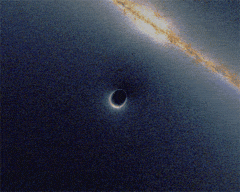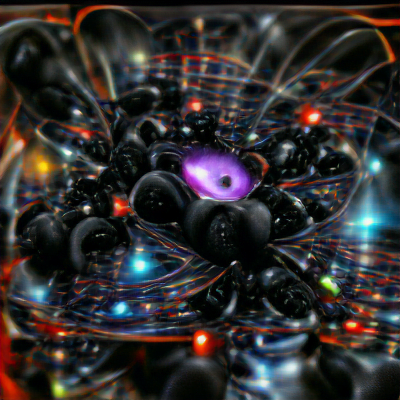Black Holes Unveiled: Demystifying Cosmic Wonders
Black holes are some of the most intriguing and enigmatic objects in the universe. In this article, we’ll embark on a journey to explore the fascinating world of black holes, delving into their formation, characteristics, and the profound impact they have on the cosmos.
What is a Black Hole?
A black hole is a region in space where gravity is so strong that nothing, not even light, can escape its grasp. THIS IS AN EMPTY SPACE. Black holes are made from the leftovers of really big stars. When a star gets really, really heavy, it sort of crumples up under its own weight, and that’s how a black hole is born.

Animated simulation of a Schwarzschild black hole with a galaxy passing behind. Around the time of alignment, extreme gravitational lensing of the galaxy is observed. Urbane Legend (optimised for web use by Alain r), CC BY-SA 3.0, via Wikimedia Commons
The origin of black holes
Initially, stars formed under conditions where the levels of radiation and gravity were balanced. When a star runs out of fuel for fusion, the level of outward radiation weakens compared to the inward gravitational force. From there, the star collapses, and then experiences a supernova explosion. In this explosion, there are 2 possible outcomes. One of them is a black hole.
Characteristics of Black Holes:
- Event Horizon: This is the boundary surrounding a black hole beyond which nothing can return. Once an object crosses this boundary, it is effectively lost to the black hole.
- Singularity: At the very center of a black hole lies a point of infinite density known as a singularity. This is where all the mass of the collapsed star is concentrated.
- Strong Gravitational Pull: Black holes have an incredibly powerful gravitational pull, which affects the motion of nearby objects and even bends the path of light.
Let’s dive into the characteristics of black holes:
- Event Horizon:
- Imagine there’s a line drawn around a black hole. This line is called the Event Horizon.
- Once anything, like a spaceship or even light, crosses this line, it’s like falling into a cosmic trap. Nothing can come back from beyond this point. It’s lost to the black hole forever.
- Singularity:
- Right at the very center of a black hole is something really strange. It’s a super tiny spot called a singularity.
- This singularity is incredibly dense, meaning it has a huge amount of stuff squished into a tiny space. It’s like all the mass of the collapsed star is squeezed into this one tiny point.
- Strong Gravitational Pull:
- Picture a powerful force, like a super strong magnet. Black holes have this kind of force, but it’s because of their intense gravity.
- This powerful pull affects everything nearby. If there are planets or other objects nearby, they’ll feel this pull and might start moving toward the black hole. Even light, which usually travels in straight lines, can be bent by this gravitational force.
So, in a nutshell, a black hole has these three main features: an Event Horizon that’s like a point of no return, a super-dense Singularity at its core, and an incredibly strong pull of gravity that can affect everything around it. It’s like a space-time whirlpool!

A growing black hole, called a quasar, can be seen at the center of a faraway galaxy in this artist’s concept. NASA, Public domain, via Wikimedia Commons
Growing black hole “quasar”
In a galaxy far, far away, there’s a special kind of black hole called a quasar. It’s like a cosmic powerhouse! Imagine it as an orange spot in the center of a big, irregular-shaped galaxy.
This quasar is like a hub of activity. It’s surrounded by a ring-shaped cloud made of dust and gas. This cloud is like a buffet for the supermassive black hole in the center. As the black hole feasts, the dust and gas get super hot and shoot out X-rays, like bright white lines.
Around the quasar, you can see stars forming in groups all over the galaxy. And if you look even further, you’ll spot other galaxies with similar quasars way in the background.
Scientists recently found a bunch of these quasars that were really good at hiding. See, some quasars are easy to spot because they shoot X-rays right at us. But others are shy, with their doughnut-shaped clouds blocking our view. Plus, there’s dust and gas in the galaxy itself that can get in the way.
Before this discovery, scientists had seen the rowdiest and most energetic quasars. But the quieter, more typical ones were like cosmic ninjas – they stayed hidden. With the help of Spitzer and Chandra, the scientists finally found them hiding in the hearts of huge galaxies that are about 9 to 11 billion light-years away. These galaxies were super busy, not only making stars but also growing their black holes at the same time.
Spitzer did this cosmic detective work as part of a special mission to study the faintest faraway galaxies. It’s like peering into the past of the universe!
Examples of Black Holes:
- Cygnus X-1: Located in the constellation Cygnus, this is one of the first strong black hole candidates ever discovered. It orbits a blue supergiant star and has provided valuable insights into the behavior of black holes in binary systems.
- Sagittarius A:* This is the supermassive black hole located at the center of our Milky Way galaxy. While it’s not actively consuming material like some other black holes, its presence has been confirmed through extensive observations.
- M87’s Black Hole: In 2019, the Event Horizon Telescope collaboration captured the first-ever image of a black hole in the Messier 87 galaxy. This historic image provided visual evidence of the existence of black holes.
Read also: Nearest Galaxy and the distance from Milky Way (our galaxy)?
Time Dilation and Black Holes:
One of the most mind-bending aspects of black holes is their influence on time. According to Einstein’s theory of relativity, time near a black hole passes more slowly compared to further away. This phenomenon, known as time dilation, has been confirmed through various experiments and observations.
Alright, let’s break this down a bit:
Imagine you’re near a black hole, which is this incredibly powerful area in space where gravity is super, super strong. Well, something really strange happens with time when you’re close to it.
You know how we experience time every day? Seconds ticking by, minutes passing, and so on? Well, if you were near a black hole, time would seem to move slower for you compared to someone who’s far away from it.
Big Bang which describes how the Universe was “born” | This Is How It Begins!
This isn’t just some wild idea. A really smart scientist named Albert Einstein figured this out with his theory of relativity. And guess what? When scientists did different tests and watched the sky, they saw that this time slowdown near a black hole is actually true! They call this whole thing “time dilation.”
So, it’s like being near a black hole is like having a special clock that ticks much slower than regular clocks far away. It’s just one of the many mind-boggling things about black holes!
Conclusion:
Black holes continue to be a source of fascination and a subject of intense scientific inquiry. While they challenge our understanding of the laws of physics, they also hold the key to unlocking some of the deepest mysteries of the universe. As technology advances, our exploration of these cosmic enigmas promises to unveil even more astonishing revelations about the nature of space, time, and gravity.
Sources: PinterPandai, Wikipedia, NASA
Photo credit (main picture): k.i. Art Machine, CC0, via Wikimedia Commons
Photo descreption: Simulated image of the unviverse of black hole galaxy.



